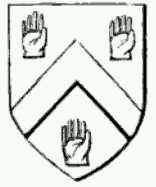- Henry Maynard
Infobox Person
name = Sir Henry Maynard

image_size = 150px
caption = Arms for Maynard ofEstaines Parva
birth_name =
birth_date = 1547
birth_place =
death_date = 1610
death_place =
death_cause =
resting_place = Little Easton Church
resting_place_coordinates =
residence =
nationality =English
other_names =
known_for = secretary to Lord Burghley
education =
employer =
occupation = politician, secretary and landowner
title =
term =
predecessor =
successor =
party =
boards =
religion = Protestant
spouse = Susan Pearson
children =
parents = John and Dorothy Maynard
relatives =
website =
footnotes =Sir Henry Maynard (1547-1610) was an English politician and secretary to Lord Burghley, and became (by steady accretion) a substantial landowner.
Origins
Maynard was the son of John Maynard, who had been MP for
St Albans in the first Parliament ofMary I of England in 1553-1554 (being one of the 39 members who absented themselves, rather than acknowledge the authority of the Pope), and his second wife, Dorothy, daughter of Robert Perrot. [http://books.google.co.uk/books?id=yFI5AAAAMAAJ&pg=PA285&lpg=PA285&dq=%22sir+henry+maynard%22+knight&source=web&ots=nStWgmTLqS&sig=C1CFw7IHwzi-__BCs10DLlUMET8&hl=en&sa=X&oi=book_result&resnum=1&ct=result#PPA283,M1| Collins’s "Peerage" (1812), volume 6] ]Political career
He was secretary to Lord Burghley, the
Lord High Treasurer , and served as MP for St. Albans in the parliaments of 1586, 1588, 1592 and 1597. "He sat on committees concerning , horse and cattle stealing, privileges, penal laws, painters and stainers, and fustians". [http://etd.lsu.edu/docs/available/etd-1107103-144724/unrestricted/Hankins_dis.pdf|Jeffery Hankins, "Local Government and Society in Early Modern England: Hertfordshire and Essex, c. 1590-1630" (2003)] ] He was also summoned to the parliament of 1601 as aknight of the shire forEssex (UK Parliament constituency) . He wasHigh Sheriff of Essex in the last year of Elizabeth’s reign and was knighted by her. In July 1603, following the accession of James I, he was appointed asDeputy Lieutenant for Essex (the newLord Lieutenant being the Earl of Sussex).In 1595-6, he acquired the manor of Tooting Graveney from James Harrington. When the Queen visited in 1600, she was probably his guest. [ [http://www.british-history.ac.uk/report.aspx?compid=45393 | Daniel Lysons, "The Environs of London" (1792), volume 1] ] .
Family
He married Susan, the daughter and co-heir of Thomas Pearson,
gentleman-usher of theStar Chamber (whose property included two inns in Queen Anne’s Gate called the White Hart and the Saracen’s Head [ [http://www.british-history.ac.uk/report.aspx?compid=67615 | Montague Cox, "Survey of London", volume 10 (1926)] ] ), and had eight sons by her. The eldest, William, became the first Lord Maynard. Another, John, became aKnight of the Bath . [http://books.google.co.uk/books?id=LKIKAAAAYAAJ&pg=PA348&dq=%22john+maynard+K.B.%22&as_brr=3| Burke's "Genealogical and Heraldic History of the Extinct and Dormant Baronetcies" (1844)] ]Death and posterity
He made his will on
20 August 1609 and it was proved on18 May 1610 . Among other bequests, he left £2,000 to each of his daughters, Elizabeth and Mary, his London properties to his son Charles, and £500 and his leasehold properties in Warwickshire to his son Francis. He was buried atLittle Easton , Essex, which he had purchased.His epitaph in Little Easton Church reads:“Here resteth, in assured hope to rise in Christ, Henry Maynard, Knight, descended of the ancient family of Maynard, in the county of Devon; and Dame Susan, his wife, daughter and one of the coheirs of Thomas Pierson, Esq. to whom she bear eight sonnes and two daughters. He ended this life the 11th of May, 1610; his lady, six sonnes, and two daughters then living.”
References
Wikimedia Foundation. 2010.
